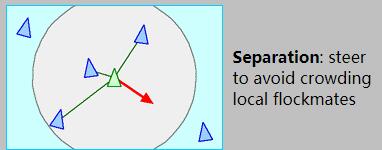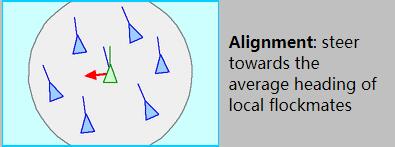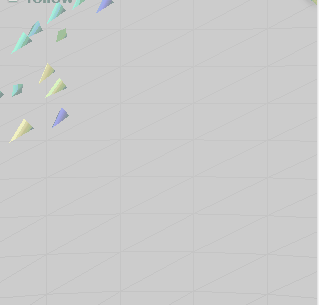Flocking
 Flocking copied to clipboard
Flocking copied to clipboard
A Flocking simulation tutorial, using webgl and canvas2d in javascript.用javascript模拟鸟群的教程
javascript模拟鸟群使用cax和threejs渲染引擎
本文会使用前端技术来模拟2d和3d鸟群,我选用canvas元素绘制,当然也可以使用css3或者svg。
实现 demo
3d的渲染我选用threejs
2d的渲染引擎我选择cax,cax是一款我非常喜欢的渲染引擎,支持小程序、小游戏以及 Web 浏览器渲染。用它既能开发小游戏也能开发图表(见wechart),强力推荐!
2d鸟群

这些鸟并不是在漫无目的的乱飞,它们看上去都拥有了智商,形成了群体,产生了复杂的群组运动效果
这看上去复杂的行为是一种复合行为,通常会拆分为下面几种:
分离(separation)
 首先对象们要尽量不能与周围的对象相互碰撞,它们彼此不能离的太近,需要给自己留出一个小空间
首先对象们要尽量不能与周围的对象相互碰撞,它们彼此不能离的太近,需要给自己留出一个小空间
内聚(cohesion)
 也不能和周围对象们离的太远了,太远会被拉回来
也不能和周围对象们离的太远了,太远会被拉回来
排队(alignment)
 它们飞行的方向也不能太乱,大体上都会往一个方向上飞,每个对象都会归到一队伍中
它们飞行的方向也不能太乱,大体上都会往一个方向上飞,每个对象都会归到一队伍中
这三个特性分离、内聚、排队组合起来,就会得到飞车逼真的鸟群(群体)
考虑到鸟群的复杂行为,我们不必知道鸟群的整体智慧。每只鸟只需要对它范围内的其他鸟运用那三个特性,自然而然的形成群落。来看下面的代码,代码没做太多优化,将就着看:
创建鸟们,添加到场景中
var birds = Array.from({length:60},(v,i)=>{
var bird = new Bird()
stage.add(bird)
Object.assign(bird,{
po: new Vector(stage.width*rd(),stage.height*rd())
,ve: new Vector(rd() * 20 - 10, rd() * 20 - 10)
,ac: new Vector()
})
return bird
})
this.tick = cax.tick(()=>{
stage.update()
birds.forEach(b=>b.update(stage,birds))
})
关键update方法
update(birds){
// 忽略自己
birds = birds.filter(o=>this!=o)
// separation
for(let bird of birds){
// 过于接近
if(this.po.distanceTo(bird.po) < Bird.sDist){
// 减去这个转向力,实现分离
this.ac.sub(
bird.po.clone()
.sub(this.po).normalize()
.multiplyScalar(Bird.MAX_SPEED)
.sub(this.ve)
)
}
}
// cohesion
let cohesion = birds.reduce((param, b)=>{
if(this.po.distanceTo(b.po) < Bird.cDist){
param.sum.add(b.po)
param.count++
}
return param
},{sum:new Vector(),count:0,force:new Vector()})
if(cohesion.count>0){
// 先求得平均位置,用平均位置求得期望的目标速度,把算出的转向力累积到加速度上
this.ac.add(
cohesion.sum.divideScalar(cohesion.count)
.sub(this.po).normalize()
.multiplyScalar(Bird.MAX_SPEED)
.sub(this.ve)
)
}
// alignment
let alignment = birds.reduce((param, b)=>{
if(this.po.distanceTo(b.po) < Bird.aDist){
param.sum.add(b.ve)
param.count++
}
return param
},{sum:new Vector(),count:0,force:new Vector()})
if(alignment.count>0){
// 先求得平均速度,用平均速度求得期望的目标速度,把算出的转向力累积到加速度上
this.ac.add(
alignment.sum.divideScalar(alignment.count).normalize()
.multiplyScalar(Bird.MAX_SPEED)
.sub(this.ve)
)
}
// 不超过最大转向力和速度
if(this.ac.length > Bird.MAX_FORCE) this.ac.normalize().multiplyScalar(Bird.MAX_FORCE)
if(this.ve.length > Bird.MAX_SPEED) this.ve.normalize().multiplyScalar(Bird.MAX_SPEED)
// 让质量大的鸟慢下来
this.ve.add(this.ac.divideScalar(this.mass))
this.po.add(this.ve)
// ...
}
就是先忽略掉自己,如果搜寻了那些过于接近的鸟,则把计算出的转向力累加到加速度上。注意的是,对于过于接近的判断其实还有个附加条件,就是在视场内。上面的代码并没有加上这个条件,不过也能模拟的较好,我就没写=w=,鸟的视场通常是180度的,是否在180度内,满足的是 this.ve.dot(this.po.clone().sub(bird.po)) < 0,
对视野和其他数值进行调整,都会形成不一样的群落效果。
我们还可以叠加多层的信息生成更复杂的模拟。这里的鸟都是一类鸟,可以添加一个老鹰对象,如果小鸟和老鹰的距离超过了一定阈值,小鸟就会立马逃跑。要模拟这种情况,只要再添加一种逃离的行为到整个系统中,这种行为还会导致小鸟的总转向力,速度全部上升。
3d鸟群

3d的实现和2d其实原理类似,唯一要注意的地方就是对象需要往目标方向的转向问题,这通常会使用四元数来进行处理,代码关键就是
this.rot.setFromQuaternion(
new THREE.Quaternion().setFromUnitVectors(new THREE.Vector3(0, 1, 0), new THREE.Vector3(this.ve.x, this.ve.y, this.ve.z).normalize())
)
this.rotation.copy(new THREE.Euler(this.rot.x,this.rot.y,this.rot.z))
参考
- http://www.red3d.com/cwr/boids/